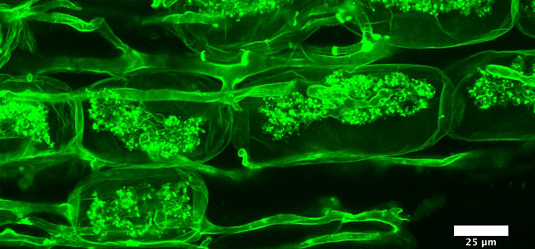Symbiosis with mycorrhizal fungi provides plants with enhanced access to scarce resources

Symbiosis with mycorrhizal fungi provides plants with enhanced access to scarce resources. LMU researchers recently discovered a mechanism that may allow host plants to control the extent of symbiosis formation.
From cereals to trees: More than 80% of land plants form symbioses with arbuscular mycorrhizal fungi. The fungi colonize the roots, and provide their host with inorganic nutrients – primarily phosphate – which are otherwise poorly accessible to plants. In return, the plants provide their fungal guests with energy-rich carbohydrates. This type of symbiosis evolved more than 400 million years ago and is indispensable for the viability of many plant species. To enable the fungi to supply the host with nutrients, their hyphal threads must first enter into the root, in which they form branched tree-like structures known as arbuscules (from the Latin arbuscula = a shrub).
The arbuscules then release the minerals, which the fungus has taken up from the surrounding soil, to the plant. "The successful formation of such alien structures inside plant cells demands a fundamental reconfiguration of the metabolism of the root cells and must be tightly regulated by the plant", explains LMU biologist Caroline Gutjahr. Together with the members of her research group, Gutjahr recently identified one of the crucial elements in this process. The findings have now appeared in the journal Current Biology.
Perhaps not surprisingly, the degree of colonization of roots by the fungi depends on the physiological status of the plant, including the level of its actual requirement for the nutrients supplied by the symbionts. Thus, if the plant already has access to an adequate supply of phosphate, formation of arbuscules is actively inhibited. "However, up until now, no molecular mechanism was known that might be capable of controlling the extent of arbuscule formation in accordance with the plant's physiological needs," Gutjahr says.
Molecular nexus
In order to pinpoint mechanisms used by the host to control arbuscule formation, the researchers focused on a mutant strain of the plant Lotus japonicus (a species of legume, related to beans, peas and lentils), in which the process is perturbed. "In this strain, we identified the gene affected by the mutation as RAM1, the product of which is required for the activation of other genes, and hence for the production of the proteins they encode", says Gutjahr. "These proteins, in turn, are very probably required to permit arbuscule formation to proceed. Their precise functions remain to be characterized in upcoming projects."
The RAM1 gene itself is strongly activated during arbuscule formation, so the mechanisms responsible for its own activation are of great interest. Gutjahr and her colleagues have now shown that two different regulatory proteins are required to induce the gene. The first is the transcription factor CYCLOPS, which was already known to play a key role in the regulation of root symbioses. The second protein, called DELLA, was also familiar, albeit in another context. DELLA forms part of a signal transduction pathway that is activated by the plant hormones called gibberellins, which are essential for the control of the plant physiology and growth. "To our surprise, we found that, in the context of RAM1 activation, CYCLOPS and DELLA interact with one another directly," says Priya Pimprikar, a doctoral student in Gutjahr's group and first author on the new study. "With this interaction, we believe we have identified, for the first time, one of the central nodes upon which information relating to symbiosis on the one hand, and plant physiology on the other, converges, thus enabling the plant to determine the extent of root colonization in accordance with its current need for phosphate, for instance", says Gutjahr.
Reducing the need for scarce resources
The symbiosis between plants and mycorrhizal fungi is also of considerable economic and ecological significance, as intensive farming requires huge inputs of artificial fertilizer each year to maintain the fertility of the soil. These fertilizers contain mineral phosphates which are only available in finite quantities, and some estimates suggest that reserves of these compounds may run out within the next 100 years. "Arbuscular mycorrhiza can help reduce the need for the application of phosphates in agriculture," Gutjahr points out. "And a better understanding of the mechanisms underlying arbuscule formation is an important prerequisite for the success of plant breeding efforts to enhance the efficiency of this type of symbiosis."
More information: Priya Pimprikar et al. A CCaMK-CYCLOPS-DELLA Complex Activates Transcription of RAM1 to Regulate Arbuscule Branching, Current Biology (2016). DOI: 10.1016/j.cub.2016.01.069
Journal information: Current Biology
Provided by Ludwig Maximilian University of Munich


















